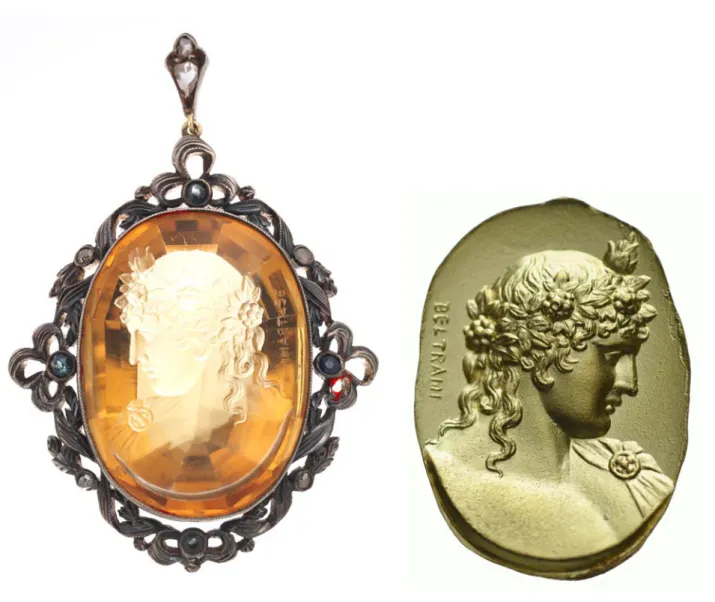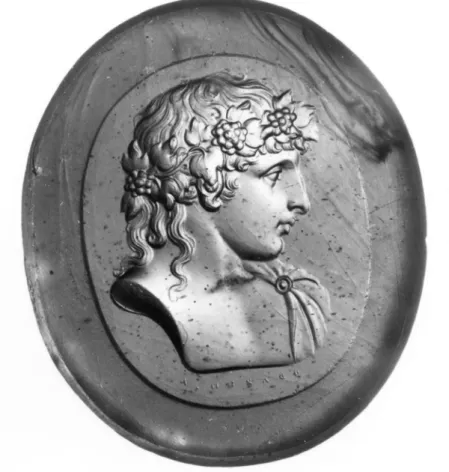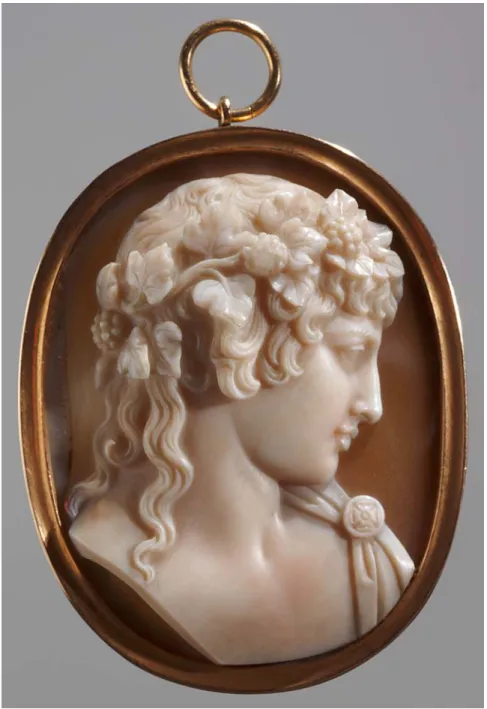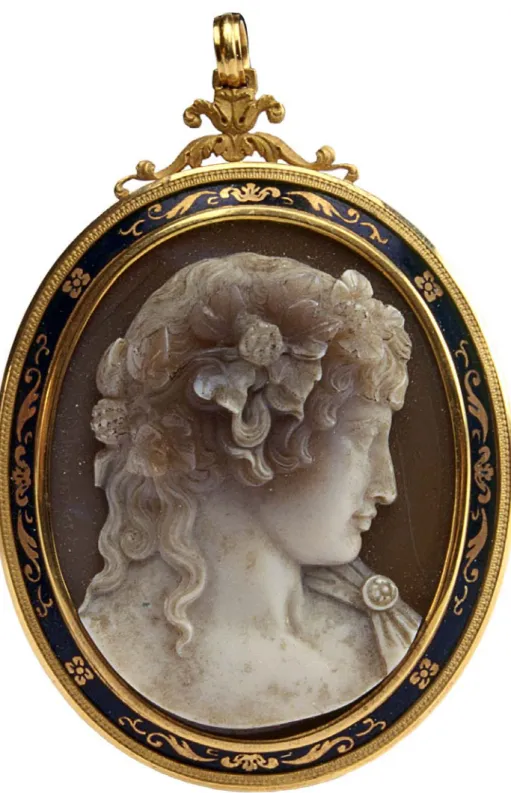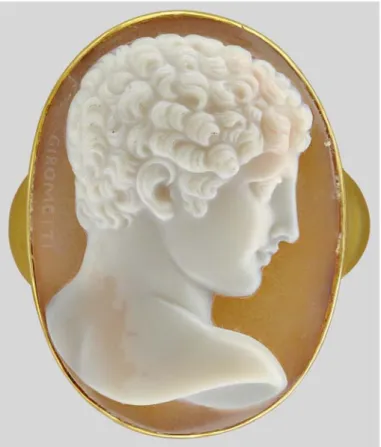Hadrien J. Rambach
The Antinous Braschi on Engraved Gems: an Intaglio by Giovanni Beltrami
*Abstract
Un grande quarzo citrino inciso è stato di recente venduto all’asta, in America, con una descrizione inesatta. Opera di Giovanni Beltrami (Cremona 1770‐1854), questo intaglio rappresenta l’Antinoo Braschi. Le gemme incise raffiguranti Antinoo sono piuttosto comuni ma normalmente esse ritraggono il rilievo Albani, la statua capitolina o l’intaglio Marlborough. Il soggetto scelto per questo citrino inedito è, invece, insolito. L’Antinoo Braschi venne ritrovato nel 1793 andando ad arricchire le collezioni pontificie nel 1843. Esso fu molto apprezzato da Giuseppe Girometti (Roma, 1779‐1851), che riprodusse il busto dell’Antinoo Braschi su numerosi cammei oggi conservati a Londra, in Vaticano e a Vienna. Anche Luigi Pichler (1773‐1854) realizzò un intaglio, oggi perduto, con lo stesso soggetto. Mancando documenti d’archivio, si deve pensare che queste gemme fossero incise per coloro che effettuavano il Gran Tour intorno agli anni 1800‐1830.
A large engraved citrine was recently sold at auction in America, misdescribed. The work of Giovanni Beltrami (Cremona 1770‐1854), this intaglio represents the Antinous Braschi. Carved gems depicting Antinous are quite common, but they usually figure the Albani relief, the Capitoline statue or the Marlborough intaglio, and this makes this unpublished jewel rather unusual. The Antinous Braschi was found in 1793, and it entered the Papal collections in 1843. This type was favoured by Giuseppe Girometti (Rome, 1779‐1851) who left several cameos of the bust of the Antinous Braschi: they are now in London, in the Vatican, and in Vienna. Luigi Pichler (1773‐1854) also carved a similar intaglio, but it is now lost. In the absence of archive documents, we must assume that these gems were carved for Grand Tourists, and a date around 1800‐1830 seems fairly certain.
On February 7th, 2013, in their auction of Important Jewels (lot 60), Sotheby’s sold in New York a
rare example of neoclassical glyptic art (Fig. 1). The engraved gem - a citrine1 - was set as an early
nineteenth-century pendant, in gold and silver, which Sotheby’s described as «a frame of ribbon scrolls and foliate motifs set with four rose-cut diamonds and four old European-cut sapphires, the bail set with two rose-cut diamonds». This mount, inspired by the style of the eighteenth-century, is probably later than Sotheby’s suggested («second quarter of the 19th Century»): these ribbons entwined with trails
of leaves, and the likely fashion to wear this jewel from a thin velvet ribbon, are more typical of an 1860s period (or even of the 1900s belle époque) - maybe an Italian frame for a miniature? The gem’s
* We wish to dedicate this text to the memory of the regretted Gertrud Seidmann (1919-2013). Our gratitude is due to Jean
Claude Grodos for his assistance in researching this iconography, to John Boardman, to Chris Cavey, to Arianna D’Ottone, to Mariacristina Guidotti, to Mario Iozzo, to Keith Penton, to Lucia Pirzio Biroli Stefanelli, to Judy Rudoe, to Diana Scarisbrick, to Fabrizio Slavazzi, to Sotheby’s, and especially to Gabriella Tassinari for her renewed advice and encouragements.
1 An intaglio of Venus and Amor, also signed by Beltrami and in a later mount, was published in PIRZIO BIROLI STEFANELLI
-LEONE 2009 as being carved on a 28 x 21 mm topaz: the colour and size suggest instead a citrine like the gem
carving is inverted, which suggests that the stone was meant as a seal: this would explain some very minor abrasion near the bezel edge and on the back at the keel (visible only under magnification), and the later re-mounting as a pendant.
The gem is signed by Giovanni Beltrami (1770-1854), and it is undoubtedly one of the masterpieces of this Italian engraver from Cremona2. (Fig. 2) It is attested that he had access to
Brazilian gemstones, as D. Sacchi tells of several Brazilian topazes he engraved (both in cameo and in intaglio)3. This is the likely provenance of this facetted oval citrine. The pre-carved weight of the stone,
which measures 32.13 x 24.41 x 11.88 mm, was estimated to be 66 carats. On January 28th, the
auction-house specialists wrote us an email to confirm that the stone showed no indication of heat treatment, though are no ways to identify a natural citrine from a heated amethyst. Both gems were anyway still of great value and rarity in the early nineteenth-century, when the Brazilian mines (discovered in 1727) and those from the Ural mountains (found in 1799) had not yet yielded huge quantities of this material, which remained hugely fashionable in the first part of the century: for example, the British Royal collection owns two citrine intaglios with the bust of George IV (dated 1822 and 1830)4.
Many artists chose to depict on gems Antinous - favourite of Emperor Hadrian (AD 117-138): for example, Edward Burch, Alessandro Cades, Carlo Costanzi, Richard Dean, Jacques Guay, Nathaniel Marchant, Luigi Michelini, Antonio Pichler, Benedetto Pistrucci, Thomas Pownall, Francesco Sirletti, Teresa Talani, and Robert Bateman Wray5. But they were all copying the “Albani” relief (i.e. Antinous
as Vertumnus) - discovered in 1735 at Tivoli, the “Capitoline” statue - found in 1733 also in the Villa Adriana, or the “Marlborough” intaglio6 - formerly in the Zanetti collection in Venice. Rather than
Antinous as Vertumnus (as the catalogue said), Beltrami’s intaglio depicts Antinous as Bacchus.
This bust was more of a novelty - as it was inspired by a recently found depiction, allowing Beltrami to innovate in his design: the gem copies the so-called “Antinous Braschi”, the most beautiful depiction of Antinous according to the British sculptor John Flaxman, a 346cm-high ancient statue that had been excavated in April 1793 in Palestrina (the ancient Preaneste).7 (Fig. 3) The importance of this
2VISCONTI 1833;SACCHI 1834;VISCONTI 1836;MENEGHELLI 1839;WURZBACH 1856;VALERIANI 1988-90;PIRZIO BIROLI
STEFANELLI 1997;TASSINARI 1999;TASSINARI 2002-3;GROVE 2006, p. 98.
3SACCHI 1834.
4ASCHENGREEN PIACENTI -BOARDMAN 2008, ns. 275-276. 5TASSINARI 2012, pp. 359-362.
6 The stone was bought by George Spencer, fourth duke of Marlborough, after a visit to Anton Maria Zanetti in 1761
(BOARDMAN 2009, n. 753 and p. 206), and not from Gavin Hamilton as suggested in Hadrien 1999, p. 261. Interestingly, an
autograph letter by Marguerite Yourcenar (auction by Ader Nordmann, Paris, 28 June 2012, lot 391) tells of the buyer of the gem at the 1952 Sotheby’s sale: «J’ai pu aussi passer plusieurs fois aux Fundi Rustici pour étudier le bas-relief d’Antoninianos que je ne connaissais encore que par de mauvaises photographies; j’ai même eu le plaisir de le signaler au grand collectionneur Sangiorgi, qui vient d’acheter la gemme Marlborough, et se propose de comparer les deux inscriptions» (the intaglio is inscribed ANT...).
marble was immediately understood: Piranesi described it within a few days,8 and a 2-year restoration
was ordered. Casts were made very shortly, too, with Viscount Morpeth acquiring one for Castle Howard. The automatic property of the Papacy, the sculpture was offered by Pope Pius VI to his nephew Duke Luigi Braschi Onesti (1745-1816). The sculpture was confiscated by the French from 1798 until 1801, but it never left Rome, and was finally sold to Pope Gregorius XIV in August 1843.
The Antinous Braschi type is rare on gems. Tommaso Saulini (1793-1864) copied this bust, in shell and maybe in onyx, but he was not the first engraver.9 Several late-nineteenth century anonymous
gems are known, both in shells and hardstones, but of inferior quality10. Instead, we can list - and
illustrate - here four other gems of great quality, in addition to Beltrami’s. Though the gem itself is lost, the existence of an intaglio by Luigi Pichler (1773-1854) is attested.11 (Fig. 4) And three onyx cameos
signed «Girometti» have survived and are preserved in European museums: in Vienna12 (Fig. 5), in the
Vatican13 (Fig. 6), and in London14 (Fig. 7). The first two are certainly the work of Giuseppe Girometti
(1779-1851), but the third was attributed by Ch. Gere to his son Pietro Girometti (1811-1859) on the basis of a different style. Another Girometti cameo of Antinous exists in Florence, never before illustrated; it is not of the Braschi type, though, as it depicts a more traditional bust of the youth, undraped and bare.15 (Fig. 8)
Since his death by drowning on 24 October A.D. 130 (aged about 19), Antinous - the «shameless
and scandalous boy»16 - had become a figure of legend. The popularity of this subject must not be a
surprise: such pieces were obviously very desirable souvenirs from the Grand Tour - especially for anyone with same-sex taste. And the engravers certainly took it as a challenge to emulate not only one of Antiquity’s most successful marble statues, but also to render successfully the portrait of Antiquity’s most attractive youth.
The list of Beltrami’s customers is most impressive: Napoléon Bonaparte, Joséphine, Eugène de Beauharnais, prince Bartolomeo Soresina Vidoni, Bartolomeo Turina, etc., and notably count
8PAPINI 2000, p. 125.
9DICKMANN DE PETRA -BARBERINI 2006, p. 97, nt. 76.
10 A shell cameo signed by Barthali was sold by Rowan & Rowan (who also sold an anonymous one), at least four were sold
by Pommerai Antiques (illustrated on www.antinoos.info which shows some more versions), one was auctioned by Phillips on 27 June 2001 (lot 18), etc. See also MAMBELLA 2008, illustrations on pp. 104-124.
11GEBHART 1925, fig. 241 (who imprecisely identified the subject as Dionysos); PIRZIO BIROLI STEFANELLI 2012, n. V.462.
Its mould in dark green glass was acquired by Pietro Paoletti (cf. TASSINARI 2005, pp. 223-226), which gives a terminus ante
quem as Paoletti died in 1834.
12 Left to the Kunsthistorisches Museum by Franz von Timoni in 1865. BERNHARD-WALCHER 1996, here fig. 8.
13 Purchased in 1845. VISCONTI 1833, p. 35, nt. 8; VISCONTI 1836, pp. 37-38, pl. VII; KAGAN 2002, fig. 7A; PIRZIO BIROLI
STEFANELLI 2003, p. 530, n. XI.1.49.
14 Purchased by Anne Hull-Grundy in 1978. GERE -RUDOE 1984, p. 136, nt. 909; Hadrien 1999, nt. 195.
15 Bequeathed by Sir William Currie in 1863 to the Archaeological Museum. MILANI 1923, p. 206, nt. 80; TASSINARI 2012,
footnote 1554.
Battista Sommariva (1760-1826). But, unfortunately, nothing is known of the provenance of this specific gem as it cannot be identified in the existing literature. In the absence of any notice in the documents of the time, a sure dating for the intaglio proves impossible. A possibility would be for the gem to be a commission, executed to commemorate the Pope’s acquisition of the statue in 1843 and following the exhibition of the statue in the Vatican - at a time when visitors of the Vatican such as the countess de Rochère would write of «la statue de l’infâme Antinoüs, dont la matérielle beauté ne saurait arrêter trop longtemps les regards»17: this is not very likely considering Beltrami’s age by then; moreover
the Girometti cameo in the Vatican was published as early as 1836 and the Pichler intaglio was moulded before 1834. A far-fetched eventuality would be for the gem to have been done for the Scottish painter Gavin Hamilton, who had been the finder of the Braschi statue; but he is only known to have had contacts with Giovanni Pichler18 and Nathaniel Marchant,19 and Beltrami rather worked for the court
and for Lombard customers. More plausible would be the hypothesis that these gems are contemporary with the fears, in 1809-1812, of the statue to be sold to the Bavarians or to the French. The original-purchaser, and the posterior history of this jewel, remain to be discovered.
Hadrien J. Rambach
17LA ROCHÈRE 1853, p. 63 (July 1849). 18TASSINARI t.b.p.
Illustrations
Fig. 1. Citrine by G. Beltrami (1770-1854), 32 x 24 mm, private
collection. Fig. 2. Gold impression of the intaglio Fig. 1, by Patrick de Pertat (April 2013), 13.16 grams.
Fig. 3. Detail of the Antinous Braschi, Museo Pio Clementino (inv. 540).
Fig. 4. Inverted photo of glass mould, after an intaglio by L. Pichler, Museo di Roma (inv. 27096), illustrated in PIRZIO BIROLI STEFANELLI 2012.
Fig. 7. Cameo by G. or P. Girometti, 61 x 46 mm, British Museum (inv. 1978,1002.815).
Bibliography
ASCHENGREEN PIACENTI -BOARDMAN 2008
K. Aschengreen Piacenti - J. Boardman, Ancient and Modern Gems and Jewels in the Collection of Her Majesty
the Queen, London 2008.
BERNHARD-WALCHER 1996
A. Bernhard-Walcher, Geschnittene Steine des 18. und 19. Jahrhunderts in der Antikensammlung des
Kunsthistorischen Museums Wien, in “Zeitschrift für Kunstgeschichte” 59.2 (1996), pp. 162-182.
BOARDMAN 2009
J. Boardman, The Marlborough Gems formerly at Blenheim Palace, Oxfordshire, Oxford 2009.
CLAIRMONT 1966
C. Clairmont, Die Bildnisse des Antinous, Rome 1966.
DICKMANN DE PETRA -BARBERINI 2006
M. Dickmann De Petra - F. Barberini, Tommaso e Luigi Saulini. Incisori di cammei nella Roma dell’Ottocento, Rome 2006.
GEBHART 1925
H. Gebhart, Gemmen und Kameen, Berlin 1925.
GERE -RUDOE 1984
C. Gere - J. Rudoe, The Art of the Jeweller. A catalogue of the Hull Grundy gift to the British Museum, London 1984.
GROVE 2006
The Grove Encyclopedia of Decorative Arts, vol. I: Aalto - Kyoto pottery, New York 2006 Hadrian 2008
Hadrian. Empire and conflict, exhibition catalogue (London 2008), London 2008. Hadrien 1999
Hadrien, trésors d’une villa impériale, exhibition catalogue (Paris 1999), Paris 1999.
KAGAN 2002
J. Kagan, Post-Classical Glyptics as Preserver of the Heritage of Antiquity, in Hadrien Empereur et Architecte. La
Villa d’Hadrien, colloquium papers, Paris 2002, pp. 139-153.
LA ROCHÈRE 1853
E. de la Rochère, Rome. Souvenirs religieux, historiques et artistiques, Tours 1853.
MAMBELLA 2008
R. Mambella, Antinoo. “Un Dio malinconico” nella storia e nell’arte, Roma 2008.
MENEGHELLI 1839
MILANI 1923
L.A. Milani, Il R. Museo Archeologico di Firenze. Sua storia e guida illustrata, Florence 1923.
PAPINI 2000
M. Papini, Palazzo Braschi. La collezione di sculture antiche, Rome 2000.
PIRZIO BIROLI STEFANELLI 1997
L. Pirzio Biroli Stefanelli, «Avea il Marchese Sommariva...una sua favorita idea». II. Le incisioni di Giovanni
Beltrami, in “Bollettino dei Musei Comunali di Roma”, n.s. 11 (1997), pp. 111-131.
PIRZIO BIROLI STEFANELLI 2003
L. Pirzio Biroli Stefanelli, Glittica, medaglistica, oreficeria. Artisti-artigiani per l’Europa, in S. Pinto - L. Barroero - F. Mazzocca (a cura di), Maestà di Roma. Da Napoleone all’Unità d’Italia. Universale ed Eterna
Capitale delle Arti, exhibition catalogue (Rome 2003), Martellago 2003.
PIRZIO BIROLI STEFANELLI 2012
L. Pirzio Biroli Stefanelli, La collezione Paoletti. Stampi in vetro per impronte di intagli e cammei, vol. II, Rome 2012.
PIRZIO BIROLI STEFANELLI -LEONE 2009
L. Pirzio Biroli Stefanelli - F. Leone, Incisori in pietra dura a Piazza di Spagna, Rome 2009.
SACCHI 1834
D. Sacchi, Il Glitografo Giovanni Beltrami, in “Indicatore ossia Raccolta Periodica di scelti articoli”, third series 2 (1834), pp. 247-252.
SEIDMANN 1987
G. Seidmann, Nathaniel Marchant, gem-engraver, 1739-1816, in “Walpole Society” 53 (1987), pp. 1-105.
TASSINARI 1999
G. Tassinari, An Intaglio by Giovanni Beltrami and Some Considerations on the Connection Between Plaquettes and
Gems in the Late 18th-early 19th Century”, in Classicism to Neo-Classicism: Essays Dedicated to Gertrud Seidmann,
Oxford 1999, pp. 192-204.
TASSINARI 2002-3
G. Tassinari, Glyptic portraits of Eugène de Beauharnais: the Intaglios by Giovanni Beltrami and the Cameo by
Antonio Berini, in “The Journal of the Walters Art Museum” 60/61 (2002/03), pp. 43-64.
TASSINARI 2005
G. Tassinari, Lettere di una celebre famiglia di incisori di pietre dure: i Pichler, in “Acme” 58/1 (2005), pp. 187-240.
TASSINARI 2012
G. Tassinari, Giovanni Pichler. Raccolta di impronte di intagli e di cammei del Gabinetto Numismatico e Medagliere
delle Raccolte Artistiche del Castello Sforzesco di Milano, Milan 2012.
TASSINARI t.b.p.
VALERIANI 1988-90
R. Valeriani, Di Giovanni Beltrami, glittografo cremonese, in “Antologia di Belle Arti” 35-38 (1988-90), pp. 23-29.
VISCONTI 1833
P.E. Visconti, Notizia delle opere dell’incisore in pietre dure ed in coni Cav. Giuseppe Girometti, Rome 1833.
VISCONTI 1836
P.E. Visconti, Gemme incise dal cavaliere Giuseppe Girometti, Rome 1836.
WURZBACH 1856
C. von Wurzbach, Beltrami Johann in “Biographisches Lexikon des Kaiserthums Oesterreich”, vol. 01, Vienna 1856, pp. 250-252.
